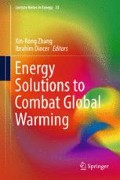Abstract
In this study, both utilization and importance of a greenization factor are emphasized. This factor is defined based on the reduction of greenhouse gas emissions of greenized energy system with respect to the base case of the reference system. Energy system with greenization factor of 1 reflect a fully greenized system with no or minimum negative environmental impact, when greenization factor of 0 indicates the reference system. The usefulness of greenization factor is demonstrated through a case study of a steam Rankine power plant for which various options of system greenization are assessed and compared based on greenization factor criterion. Exergy efficiency, improvement potential and exergetic sustainability index are also used in the comparative assessment. It is concluded that greenization factor can play a relevant role for energy system assessment in view of environmental impact reduction, greenhouse gas emission reduction and improved sustainability. This will definitely contribute to identification and promotion of those solutions which lead to global warming effect reduction.
Access this chapter
Tax calculation will be finalised at checkout
Purchases are for personal use only
Abbreviations
- c p :
-
Specific heat at constant pressure, kJ/kg K
- ex:
-
Specific exergy, kJ/kg
- exch :
-
Specific chemical exergy, kJ/kg
- \( \mathop {\text{E}}\limits^{.} \) :
-
Energy rate, kW
- \( \mathop {\text{Ex}}\limits^{.} \) :
-
Exergy rate, kW
- h :
-
Specific enthalpy, kJ/kg
- \( \mathop m\limits^{.} \) :
-
Mass flow rate, kg/s
- P :
-
Pressure, kPa
- \( \dot{Q} \) :
-
Heat flow rate, kJ/s
- s :
-
Specific entropy, kJ/kg K
- T :
-
Temperature, °C, K
- v :
-
Specific volume, m3/kg
- \( \dot{W} \) :
-
Work, kW
- \( y_{P} \) :
-
Molar fraction of products
- \( y_{R} \) :
-
Molar fraction of reactants
- \( \lambda \) :
-
Excess air
- \( \eta \) :
-
Energy efficiency, %
- \( \phi \) :
-
Chemical exergy coefficient
- \( \psi \) :
-
Exergy efficiency, %
- \( \omega \) :
-
Moisture content
- CHP:
-
Combined heat and power
- CV:
-
Calorific value
- EI:
-
Environmental Impact
- GF:
-
Greenization factor
- GHG:
-
Greenhouse gas
- HHV:
-
High heating value, kJ/kg
- IP:
-
Improvement potential, MW
- LHV:
-
Lower heating value, kJ/kg
- SI:
-
Sustainability index
References
Kemmler A, Spreng D (2007) Energy indicators for tracking sustainability in developing countries. Energy Policy 35(4):2466–2480
Santoyo-Castelazo E, Azapagic A (2014) Sustainability assessment of energy systems: integrating environmental, economic and social aspects. J Clean Prod 80:119–138
Liu G (2014) Development of a general sustainability indicator for renewable energy systems: a review. Renew Sustain Energy Rev 31:611–621
Hadian S, Madani K (2015) A system of systems approach to energy sustainability assessment: are all renewables really green? Ecol Ind 52:194–206
Dincer I, Zamfirescu C (2012) Potential options to greenize energy systems. Energy 46:5–15
Dincer I (2002) The role of exergy in energy policy making. Energy Policy 30:137–149
Dincer I, Hussain MM, Al-Zaharnah I (2004) Energy and exergy use in public and private sector of Saudi Arabia. Energy Policy 32(141):1615–1624
Van Gool W (1997) Energy policy: fairly tales and factualities. In: Soares ODD et al (eds) Innovation and technology-strategies and policies. Kluwer, Dordrecht
Dincer I, Rosen MA (2013) Exergy, energy, environment and sustainable development. Elsevier, Oxford
El-Emam RS, Dincer I, Naterer GF (2012) Energy and exergy analyses of an integrated SOFC and coal gasification system. Int J Hydrogen Energy 37:1689–1697
Kotas TJ (1995) The exergy method of thermal plant analysis. Krieger Publishing Co., Malabar
El-Emam RS, Okasha FM, El-Emam SH (2014) Clean combustion of low quality fuel in fluidized bed combustor. In: Dincer I et al (eds) Progress in sustainable energy technologies vol II: creating sustainable development. Springer, Cham, pp 531–546
Jenkins BM (1989) Physical properties of biomass. In: Kitani O et al (eds) Biomass handbook. Gordon & Breach Science, Amsterdam
El-Emam RS, Dincer I, El-Emam SH (2015) Gasification of biomass for hydrogen and power production: efficiency and environmental assessment. In: Dincer I et al (eds) Progress in clean energy, vol II: novel systems and applications. Springer, Cham, pp 147–162
El-Emam RS, Dincer, I, El-Emam, SH (2014) Efficiency and environmental assessment of biomass gasification for hydrogen and power production. In: Global conference on global warming, Beijing, China
El-Emam RS, Dincer I (2014) Thermal modelling of fluidized bed gasification of rice straw. In: Proceedings of the international conference on clean energy (ICCE), Istanbul, Turkey, pp 2242–2253
Basu P (2010) Biomass gasification and pyrolysis: practical design and theory. Elsevier, Burlington
El-Emam RS, Dincer I (2015) Modeling of fluidized bed gasification of rice straw in Egypt. In: Dincer I et al (eds) Progress in clean energy, volume 1: analysis and modeling. Springer, Cham, pp 57–71
El-Emam RS, Dincer I (2015) Thermal modeling and efficiency assessment of an integrated biomass gasification and solid oxide fuel cell system. Int J Hydrogen Energy 40:7694–7706
Author information
Authors and Affiliations
Corresponding author
Editor information
Editors and Affiliations
Rights and permissions
Copyright information
© 2017 Springer International Publishing Switzerland
About this chapter
Cite this chapter
El-Emam, R.S., Dincer, I., Zamfirescu, C. (2017). Greenization Factor as a Sustainability Measure for Energy Systems. In: Zhang, X., Dincer, I. (eds) Energy Solutions to Combat Global Warming. Lecture Notes in Energy, vol 33. Springer, Cham. https://doi.org/10.1007/978-3-319-26950-4_34
Download citation
DOI: https://doi.org/10.1007/978-3-319-26950-4_34
Published:
Publisher Name: Springer, Cham
Print ISBN: 978-3-319-26948-1
Online ISBN: 978-3-319-26950-4
eBook Packages: EnergyEnergy (R0)

